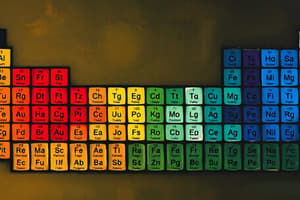Podcast
Questions and Answers
What is the main way that elements are organized in the periodic table?
What is the main way that elements are organized in the periodic table?
- By chemical properties
- By atomic number (number of protons in the nucleus) (correct)
- By atomic mass
- By electron configuration
What type of chemical reaction involves the combination of two or more substances to form a new compound?
What type of chemical reaction involves the combination of two or more substances to form a new compound?
- Single displacement reaction
- Neutralization reaction
- Synthesis reaction (correct)
- Decomposition reaction
What is the term for the study of the quantitative relationships between reactants and products in chemical reactions?
What is the term for the study of the quantitative relationships between reactants and products in chemical reactions?
- Stoichiometry (correct)
- Chemical kinetics
- Thermodynamics
- Electrochemistry
What is the term for a substance that speeds up a chemical reaction without being consumed or altered?
What is the term for a substance that speeds up a chemical reaction without being consumed or altered?
What is the primary way that the periodic table is divided?
What is the primary way that the periodic table is divided?
What is the term for the substances on the right side of a chemical equation?
What is the term for the substances on the right side of a chemical equation?
What is the term for a reaction in which a single compound breaks down into two or more substances?
What is the term for a reaction in which a single compound breaks down into two or more substances?
What is the term for the amount of a substance per unit volume?
What is the term for the amount of a substance per unit volume?
What is the term for a reaction in which one element displaces another element from a compound?
What is the term for a reaction in which one element displaces another element from a compound?
What is the term for the representation of a chemical reaction using chemical formulas and symbols?
What is the term for the representation of a chemical reaction using chemical formulas and symbols?
Flashcards are hidden until you start studying
Study Notes
Periodic Table
- The periodic table is a tabular display of the known chemical elements, organized by their atomic number (number of protons in the nucleus), electron configuration, and recurring chemical properties.
- The elements are listed in order of increasing atomic number (number of protons in the nucleus) and are grouped into rows called periods and columns called groups or families.
- The periodic table is divided into different sections:
- Metals (left side and center of the periodic table)
- Nonmetals (right side of the periodic table)
- Metalloids (border between metals and nonmetals)
- The periodic table allows us to:
- Identify relationships between elements
- Predict chemical properties and behaviors
- Identify trends and patterns in element properties
Chemical Reactions
Types of Chemical Reactions
- Synthesis reactions: two or more substances combine to form a new compound
- Decomposition reactions: a single compound breaks down into two or more substances
- Single displacement reactions: one element displaces another element from a compound
- Neutralization reactions: an acid reacts with a base to form a salt and water
Chemical Reaction Basics
- Chemical equations: representations of chemical reactions using chemical formulas and symbols
- Reactants: substances on the left side of the equation
- Products: substances on the right side of the equation
- Stoichiometry: the study of the quantitative relationships between reactants and products in chemical reactions
- Moles: units of measurement for the amount of a substance
- Molar ratios: ratios of moles of reactants to moles of products
Factors Affecting Chemical Reactions
- Concentration: the amount of a substance per unit volume
- Temperature: an increase in temperature generally increases the rate of reaction
- Surface area: an increase in surface area generally increases the rate of reaction
- Catalysts: substances that speed up chemical reactions without being consumed or altered
Periodic Table
- The periodic table displays chemical elements organized by atomic number, electron configuration, and recurring chemical properties.
- Elements are listed in order of increasing atomic number and grouped into periods (rows) and groups or families (columns).
- The table is divided into metals (left side and center), nonmetals (right side), and metalloids (border between metals and nonmetals).
- The periodic table allows for:
- Identifying relationships between elements
- Predicting chemical properties and behaviors
- Identifying trends and patterns in element properties
Chemical Reactions
Types of Chemical Reactions
- Synthesis reactions: combine two or more substances to form a new compound
- Decomposition reactions: break down a single compound into two or more substances
- Single displacement reactions: one element displaces another element from a compound
- Neutralization reactions: acid reacts with a base to form a salt and water
Chemical Reaction Basics
- Chemical equations represent reactions using chemical formulas and symbols
- Reactants: substances on the left side of the equation
- Products: substances on the right side of the equation
- Stoichiometry studies quantitative relationships between reactants and products
- Moles: units of measurement for the amount of a substance
- Molar ratios: ratios of moles of reactants to moles of products
Factors Affecting Chemical Reactions
- Concentration: amount of a substance per unit volume affects reaction rate
- Temperature: increasing temperature generally increases reaction rate
- Surface area: increasing surface area generally increases reaction rate
- Catalysts: substances that speed up reactions without being consumed or altered
Studying That Suits You
Use AI to generate personalized quizzes and flashcards to suit your learning preferences.




